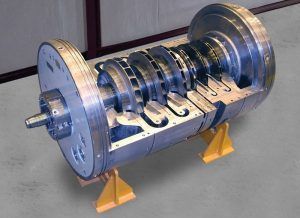Time to rethink nozzle load limitations on turbomachines

Picture courtesy Siemens (Dresser-Rand)[/caption]
One of the biggest challenges when dealing with turbomachinery (such as pumps, compressors, steam turbines, and others) is low allowable forces and moments on nozzles. This has a great effect on the piping connected to turbomachines and consequently the operation, reliability and maintenance of the machines as well as connected piping. An example is integrally-geared centrifugal compressors where the allowable nozzle loads is often less than half the ones on conventional centrifugal compressors. Allowable nozzle loads of high speed steam turbines and axial compressors have also been low.
The problem is that sensitive turbomachines cannot endure even a slight deformation, or else risk the consequence of shaft misalignment or other issues. To maintain smooth operation, the shaft needs to be kept in perfect alignment without causing binding at the bearings and interference of the internal parts. Therefore, the acceptance criterion of nozzle loads is nearly always the strain rather than the stress. As a very rough indication, the allowable strain on the nozzles of many turbomachines is only equivalent to about 10-20% of the ones when the allowable piping stress criterion is applied.
Manufacturers vs piping engineers
There should ideally be no piping load on nozzles of turbomachines, but this is not possible. The common practice is for the turbomachinery manufacturer to specify a set of reasonable and achievable allowable nozzle load to which a carefully optimized piping can be provided. However, allowable nozzle loads given by some manufacturers are assessed as too small by many piping stress specialists. These experts argue actual loads that can be taken could be higher. This is a controversial and challenging suggestion.
Most turbomachinery purchasing contracts have a clause stating that the manufacturer will guarantee the performance, reliability and integrity of the turbomachinery only when the piping load is within the allowable limit. Low values of allowable piping load have improved reliability. However, it has created many challenges and difficulties by requiring unusual and unique piping layouts so as to piping reaction loads.
To reduce the piping load below allowable limits, many laborious layouts and ingenious support schemes have been used by piping engineers worldwide. The challenging and complex piping arrangements have usually resulted in meeting allowable loads. Then the specific aspect of turbomachinery reliability and operation is met. However, it should also be checked that the reliability and integrity of the overall system of machinery piping is not actually compromised by such a complex piping. The great effort required for a piping system connected to a turbomachinery should be appreciated by turbomachinery engineers and experts (including manufacturers). This can easily be several times the effort needed for a comparable ordinary piping system, the one not connected to a turbomachinery.
Core problems
It is a matter of great debate if turbomachines could be manufactured to take a higher nozzle load without grossly increasing cost and complexity. The answer depends on the type and details of turbomachinery, operational conditions and environments, and the connected and surrounding items. There is usually a weak link in the system: inherent weakness or an item is overlooked in the design.
The turbomachinery body is usually designed and manufactured to be stronger than the piping connected to it, so that the body theoretically can resist the same internal pressure and forces as the piping. The foundation, normally, is also massive and stiff. It is also designed for the piping load and shaft torque as specified.
One of the weak points is the pedestal or base plate. For some turbomachinery packages, the pedestal or baseplate is provided only by shaft torque and machinery weight without considering any piping load or any other loading. This is obviously not enough. The author has observed weak and flimsy pedestals and base plates especially in older designs.
There have been cases where the specified double (2×) or triple (3×) API allowable nozzle loads could be achieved by a stronger base plate or pedestal. In those cases, a strong base plate or pedestal was used, but the overall cost of the turbomachinery package was only marginally more than the package with (1×) API allowable nozzle loads.
The key point is to identify and improve weak link(s) to avoid unnecessary reduction in allowable nozzle loads so the strength and rigidity of the whole turbomachinery package becomes fairly-uniform. This is often a complicated and complex task. Every part, component, connection, etc should be examined within a very crowded and complex turbomachinery package.
The caveat is that the above-mentioned guidelines cannot be generalised and many turbomachines have some inherent weakness such as the requirement for very fine alignment that prevent any attempt to increase nozzle loads.